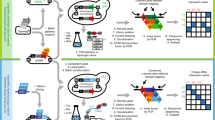Abstract
A variety of techniques can be used to find protein partners, including immunoprecipitation, affinity chromatography, blot overlays, and yeast twohybrid screening. Of these, the blot overlay protocol of sodium dodecyl sulfate (SDS)-acrylamide-gel-separated proteins provides perhaps the most direct assessment of target binding, since one can simultaneously screen multiple cell types or tissue extracts, and infer the size-and in some cases the relative affinity-of binding proteins. Combined use with other techniques such as protein fractionation and affinity chromatography, blot overlay allows us to trace target proteins and undertake their purification. Overlays have also been successfully used for screening of expression libraries (see refs. 1,2, yet the success of the yeast two-hybrid system (3) has partially eclipsed the use of this method for cDNA screening.
Access this chapter
Tax calculation will be finalised at checkout
Purchases are for personal use only
Similar content being viewed by others
References
Cicchetti, P., Mayer, B. J., Thiel, G., and Baltimore, D. (1992) Identification of a protein that binds to the SH3 region of Abl and is similar to Bcr and GAP-rho. Science 257, 803–806.
Ren, R., Mayer, B. J., Cicchetti, P., and Baltimore, D. (1993) Identification of a ten-amino acid proline-rich SH3 binding site. Science 259, 1157–1161.
Fields, S. and Song, O. (1989) A novel genetic system to detect protein-protein interactions. Nature 340, 245–246.
Fouassier, L., Yun, C. C., Fitz, J. G., and Doctor, R. B. (2000) Evidence for ezrinradixin-moesin-binding phosphoprotein 50 (EBP50). Self-association through PDZ-PDZ Interactions. J. Biol. Chem. 275, 25,039–25,045.
Kaelin, W. G., Jr., Krek, W., Sellers, W. R., DeCaprio, J. A., Ajchenbaum, F., Fuchs, C. S., et al. (1992) Expression cloning of a cDNA encoding a retinoblastomabinding protein with E2F-like properties. Cell 70, 351–364.
Ron, D. and Dressler, H. (1992) pGSTag-a versatile bacterial expression plasmid for enzymatic labeling of recombinant proteins. Biotechniques 13, 866–869.
Feller, S. M., Knudsen, B., Wong, T. W., and Hanafusa, H. (1995) Detection of SH3-binding proteins in total cell lysates with glutathione S-transferase-SH3 fusion proteins: SH3 blot assay. Methods Enzymol. 255, 369–378.
Pawson, T. (1995) Protein modules and signalling networks. Nature 373, 573–580.
Cohen, G. B., Ren, R., and Baltimore, D. (1995) Modular binding domains in signal transduction proteins. Cell 80, 237–248.
John, J., Sohmen, R., Feuerstein, J., Linke, R., Wittinghofer, A., and Goody, R. S.(1990) Kinetics of interaction of nucleotides with nucleotide-free H-ras p21.Biochemistry 29, 6058–6065.
Hara, M., Tamaoki, T., and Nakano, H. (1988) Guanine nucleotide binding properties of purified v-Ki-ras p21 protein produced in Escherichia coli. Oncogene Res. 2, 325–333.
Hall, A. and Self, A. J. (1986) The effect of Mg2+on the guanine nucleotide exchange rate of p21N-ras. J. Biol. Chem. 261, 10,963–10,965.
Manser, E., Leung, T., Monfries, C., Teo, M., Hall, C., and Lim, L. (1992) Diversity and versatility of GTPase activating proteins for the p21rho subfamily of ras G proteins detected by a novel overlay assay. J. Biol. Chem. 267, 16,025–16,028.
Manser, E., Leung, T., Salihuddin, H., Zhao, Z. S., and Lim, L. (1994) A brain serine/threonine protein kinase activated by Cdc42 and Rac1. Nature 367, 40–46.
Leung, T., Chen, X. Q., Manser, E., and Lim, L. (1996) The p160 RhoA-binding kinase ROK alpha is a member of a kinase family and is involved in the reorganization of the cytoskeleton. Mol. Cell. Biol. 16, 5313–5327.
Tanaka, S., Morishita, T., Hashimoto, Y., Hattori, S., Nakamura, S., Shibuya, M.,et al. (1994) C3G, a guanine nucleotide-releasing protein expressed ubiquitously,binds to the Src homology 3 domains of CRK and GRB2/ASH proteins. Proc.Natl. Acad. Sci. USA 91, 3443–3447.
Sastry, L., Lin, W., Wong, W. T., Di Fiore, P. P., Scoppa, C. A., and King, C. R.(1995) Quantitative analysis of Grb2-Sos1 interaction: the N-terminal SH3 domain of Grb2 mediates affinity. Oncogene 11, 1107–1112.
Manser, E., Huang, H. Y., Loo, T. H., Chen, X. Q., Dong, J. M., Leung, T., et al.(1997) Expression of constitutively active alpha-PAK reveals effects of the kinase on actin and focal complexes. Mol. Cell. Biol. 17, 1129–1143.
Zhao, Z. S., Manser, E., and Lim, L. (2000) Interaction between PAK and Nck:a template for Nck targets and role of PAK autophosphorylation. Mol. Cell. Biol.20, 3906–3917.
Park, D. (1997) Cloning, sequencing, and overexpression of SH2/SH3 adaptor protein Nck from mouse thymus. Mol. Cells 7, 231–236.
Lim, K., Ho, J. X., Keeling, K., Gilliland, G. L., Ji, X., Ruker, F., et al. (1994) Three-dimensional structure of Schistosoma japonicum glutathione S-transferase fused with a six-amino acid conserved neutralizing epitope of gp41 from HIV.Protein Sci. 3, 2233–2244.
Author information
Authors and Affiliations
Editor information
Editors and Affiliations
Rights and permissions
Copyright information
© 2002 Humana Press Inc.
About this protocol
Cite this protocol
Zhao, Z., Lim, L. (2002). A Ras-Based Module to Generate 32P-Labeled Fusion Proteins for Blot Overlays. In: Manser, E., Leung, T. (eds) GTPase Protocols. Methods in Molecular Biology™, vol 189. Springer, Totowa, NJ. https://doi.org/10.1385/1-59259-281-3:087
Download citation
DOI: https://doi.org/10.1385/1-59259-281-3:087
Publisher Name: Springer, Totowa, NJ
Print ISBN: 978-0-89603-934-6
Online ISBN: 978-1-59259-281-4
eBook Packages: Springer Protocols




